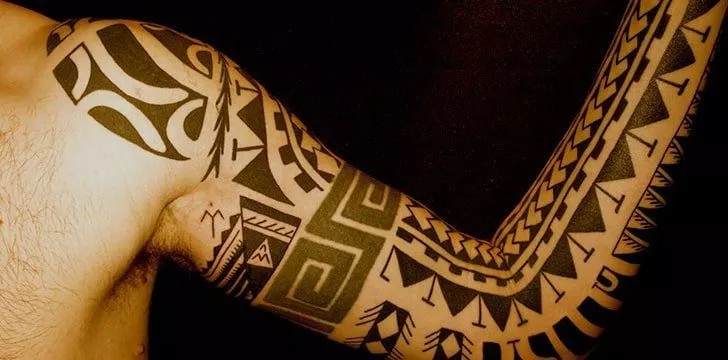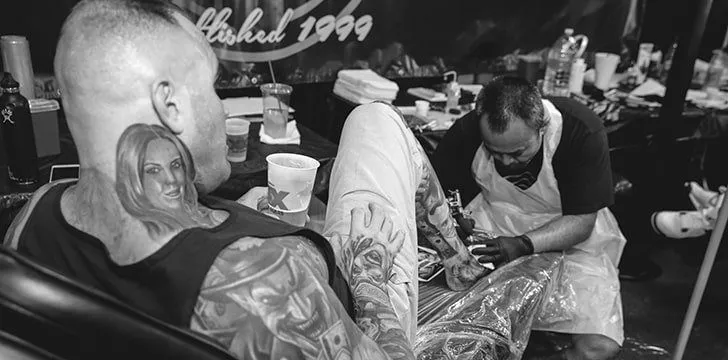In the past, tattoos were used as a form of punishment for criminals to mark them as such.
Tattoos have been a part of human culture throughout history, appearing in various regions across the globe such as East Asia, the South Pacific, North and South America, India and Europe.
Tattoos have become a ubiquitous part of modern society, as humans have an intrinsic desire to modify their bodies through tattoos and piercings.
Tattoos serve as a form of identity, with some cultures viewing them as symbols of power and dominance.
For instance, in Japan, tattoos were used to brand criminals and outcasts, while in India, they signified wealth and social status.
Regardless of cultural differences, tattooing is undoubtedly an art form.
In the modern world, three distinct styles of tattooing stand out, each with its unique cultural significance and artistic appeal.
Polynesian

The Polynesian style of tattooing is particularly popular among young men and holds significant cultural value for those who bear them.
For instance, the Maori people of New Zealand view their tattoos as sacred, representing their tribe and serving as a signature for significant life events.
Polynesian tattoos feature abstract, intricate designs with strong, distinct lines, while others are thinner and more complex.
When European colonizers arrived in Polynesia in the 19th century, they forced the natives to cover up their tattoos until the Western population began to appreciate their artistry, thanks to Captain James Cook’s introduction of a Native Maori to London.
Far East

The Far East style of tattooing is widely recognized and appreciated across the world and blends traditional Chinese techniques to create stunning designs that are no longer associated with criminal gangs like the Yakuza in Japan.
The Horitoshi family, based in Tokyo, Japan, is renowned for producing some of the best tattoo artists in the Far East today.
In the past, early Chinese artists frowned upon tattooing, believing it to be a barbaric practice that defiled the body, which they saw as a gift from their ancestors and nature.
However, Western dignitaries who visited the Far East in the 18th century helped change these perceptions, and foreign nationals were allowed to be tattooed by local artists.
King George V of England was among those who returned from the Far East with tattoos.
Initially, tattoos were used in the Far East as a punishment for criminals in the 19th century, but with the arrival of Western traders, they became a popular form of decoration and inspiration for high-colored full-body illustrations in woodblock paintings.
American Art

Cholo art, a traditional West Coast Hispanic artwork, is the basis for most tattoos in America today.
Over the years, popular cultures have had a significant impact on art, expanding its boundaries. Cholo art, which includes line drawings, portraits, and scripted words and phrases, has gained immense popularity with TV shows like Miami Ink and LA Ink dominating the airwaves. Tattoo artists Kat Von D and Chris Garver are considered the King and Queen of cholo portrait art by many.
FAQ
1. What is a tattoo?
A tattoo is a form of body modification, where a design or art is made by inserting ink into the skin’s dermis layer. Tattoos can be permanent or temporary and can range from simple designs to complex artwork.
2. How are tattoos made?
Tattoos are made by using a tattoo machine, which has a needle that punctures the skin repeatedly to inject ink into the dermis layer. The artist creates the design on a stencil and transfers it onto the skin before starting the tattooing process.
3. How long does it take to get a tattoo?
The time it takes to get a tattoo depends on the design’s complexity and size. A small, simple tattoo can take around 30 minutes, while a large, intricate tattoo can take several hours or multiple sessions to complete.
4. How painful is getting a tattoo?
The pain level of getting a tattoo varies from person to person and depends on the location of the tattoo. Areas with more nerve endings, like the ribs or the feet, can be more painful than areas like the upper arm or back. However, most people describe the pain as a manageable discomfort.
5. Can tattoos be removed?
Yes, tattoos can be removed through laser tattoo removal, which breaks down the ink particles in the skin. However, the process can be painful, expensive, and may not completely remove the tattoo.
6. Are there any risks to getting a tattoo?
Getting a tattoo can come with some risks, including infection, allergic reactions, and scarring. It’s important to choose a reputable tattoo artist and follow proper aftercare instructions to minimize the risk of complications.
7. What should I consider before getting a tattoo?
Before getting a tattoo, it’s important to carefully consider the design, placement, and potential long-term effects of the tattoo. It’s also important to research and choose a reputable tattoo artist who uses safe and sterile equipment.
8. What are some popular tattoo designs?
Popular tattoo designs vary by culture and personal preference, but some common designs include animals, symbols, quotes, and portraits. Tribal tattoos, sleeve tattoos, and watercolor tattoos are also popular styles.

Zayn Anderson is a prolific writer with a passion for uncovering the world’s intriguing facts. Armed with an insatiable curiosity, he delves into various subjects, from history and science to nature and technology.
